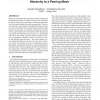Free Online Productivity Tools
i2Speak
i2Symbol
i2OCR
iTex2Img
iWeb2Print
iWeb2Shot
i2Type
iPdf2Split
iPdf2Merge
i2Bopomofo
i2Arabic
i2Style
i2Image
i2PDF
iLatex2Rtf
Sci2ools
CONEXT
2010
ACM
2010
ACM
The Internet is flat: modeling the transition from a transit hierarchy to a peering mesh
Recent measurements and anecdotal evidence indicate that the Internet ecosystem is rapidly evolving from a multi-tier hierarchy built mostly with transit (customer-provider) links to a dense mesh formed with mostly peering links. This transition can have major impact on the global Internet economy as well as on the traffic flow and topological structure of the Internet. In this paper, we study this evolutionary transition with an agent-based network formation model that captures key aspects of the interdomain ecosystem, viz., interdomain traffic flow and routing, provider and peer selection strategies, geographical constraints, and the economics of transit and peering interconnections. The model predicts several substantial differences between the Hierarchical Internet and the Flat Internet in terms of topological structure, path lengths, interdomain traffic flow, and the profitability of transit providers. We also quantify the effect of the three factors driving this evolutionary tra...
| Added | 10 Feb 2011 |
| Updated | 10 Feb 2011 |
| Type | Journal |
| Year | 2010 |
| Where | CONEXT |
| Authors | Amogh Dhamdhere, Constantine Dovrolis |
Comments (0)

